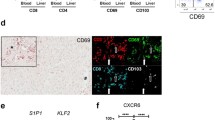Abstract
The localization and distribution of γ δ T cell receptor (TCR)-positive cells (γ δ T cells) in hepatocellular carcinoma capsules was investigated immuno-histochemically at both light and electron microscopic levels. Most of the mononuclear cells infiltrating the tumor capsules were CD3-positive. Together with γ δ T cells, they were significantly increased in the tumor capsules compared to amounts in the fibrous septa in non-cancerous cirrhotic areas of the same liver, and cirrhosis. Phenotypic characterization by the two-color double-staining technique showed that CD8γ δ cells were significantly increased in the tumor capsule, and that more than one-third of γ δ TCR-positive cells also expressed the CD56 antigen. Morphological observation revealed that large γ δ T cells were increased in number in the tumor capsule and that the cytoplasm of these cells contained multivesicular bodies and dense granules. These morphological features were similar to those of large granular lymphocytes, and most of the γ δ T cells were also positive for BB3. This suggests that extrathymic maturation of γ δ T cells occurs in the tumor capsule, and that these γ δ T cells may have a cytolytic effect on tumor cells, as shown in large gramular lymphocytes; further, the results suggest that these cells may play a role in the defense against tumor expansion.
Similar content being viewed by others
References
Bonneville M. Intestinal intraepithelial lymphocytes are a distinct set of γ δ T cells. Nature 1988;336:479–481.
Takagaki Y, Decloux A, Bonneville M, et al. Diversity of γ δ T cell receptors on murine intestinal intraepithelial lymphocytes. Nature 1989;339:712–714.
Koning F, Stingl, G, Yokoyama WM, et al. Identification of a T3-associated γ δ T cell receptor on Thy-1+ dendritic epidermal cell lines. Science 1987;236:834–837.
Kuziel WA, Takashima A, Bonyhadi M, et al. Regulation of T-cell receptor δ-chain RNA expression in murine Thy-1+ dendritic epidermal cells. Nature 1987;328:263–266.
Havran WL, Grell S, Duwe G, et al. Limited diversity of T-cell receptor δ-chain expression of murine Thy-1+ dendritic epidermal cells revealed by V γ 3-specific monoclonal antibody. Proc Natl Acad Sci USA 1989;86:4185–4189.
Augustin A, Kubo R, Sim GK. Resident pulmonary lymphocytes expressing the γ/δ T-cell receptor. Nature 1989;340:239–241.
Rajasekar R, Sim GK. Self heat shock and γ δ T-cell reactivity. Proc Natl Acad Sci USA 1990;87:1767–1771.
Kabelitz D. Function and specificity of human γ/δ-positive T cells. Crit Rev Immunol 1992;11:281–303.
Morita CT, Verma S. Functionally distinct subsets of human γ/δ T cells. Eur J Immunol 1991;21:2999–3007.
Saito T, Pardoll DM. A murine thymocyte clone expressing γ δ T-cell receptor mediates natural killer-like cytolytic function and TH1-like lymphokine production. Cell Immunol 1990;131:284–301.
Soderatrom K, Halapi E. Synovial cells responding to a 65-kDa mycobacterial heat shock protein have a high proportion of a TcR γ δ subtype uncommon in peripheral blood. Scand J Immunol 1990;32:503–515.
Moretta L, Ciccone E. Human T lymphocytes expressing γ/δ T cell antigen receptor. Clin Immunol Immunopathol 1989;50:S117–123.
Seki S, Nagura H. Identification of activated T cell receptor γ δ lymphocytes in the liver of tumor-bearing hosts. J Clin Invest 1990;86:409–415.
Alam SM, Clark JS. T cell receptor gamma/delta expression on lymphocyte populations of breast cancer patients. Immunol Lett 1992;31:279–284.
Yoshino I. T lymphocytes bearing γ/δ-type T-cell receptor in thymic tumor tissues. J Natl Cancer Inst 1992;84:22, 1755.
Kanayama K, Morise K. Immunohistochemical study of T cell receptor γ δ cells in chronic liver disease. Am J Gastroenterol 1992;87:1018–1022.
Grossi CE, Ciccone E, Migone N, et al. Human T cells expressing the γ δ T-cell receptor (TcR-1): C γ 1- and C γ 2-encoded forms of the receptor correlate with distinctive morphology, cytoskeletal organization, and growth characteristics. Proc Natl Acad Sci USA 1989;86:1619–1623.
Fukushima K, Masuda T. Immunohistochemical characterization, distribution, and ultrastructure of lymphocytes bearing T-cell receptor γ/δ in inflammatory bowel disease. Gastroenterology 1991;101:670–678.
Ohtani H, Nakamura, S, Nagura H, et al. Immunocytochemical localization of basic fibroblast growth factor in carcinomas and inflammatory lesions of the human digestive tract. Lab Invest 1993;68:520–527.
Mizoi T, Ohtani H, Nagura H, et al. Immunoelectron microscopic localization of transforming growth factor β 1 binding protein in human gastrointestinal carcinomas: Qualitative difference between cancer cells and stromal cells. Cancer Res 1993;53:183–190.
Goodman T, Lefrancoes L. Expression of the γ δ T-cell receptor on intestinal CD8+ intraepithelial lymphocytes. Nature 1988;333:855–858.
Bottino C, Tambussi G, Fertini S, et al. Two subsets of human T lymphocytes expressing γ/δ antigen receptor are identifiable by monoclonal antibodies directed to two distinct molecular forms of the receptor. J Exp Med 1988;168:491–505.
Ferrarini M. A lympholiferative disorder of the large granular lymphocytes with natural killer activity. J Clin Immunol 1983;3:30–41.
Barlozzari T, Leonhardt J. Direct evidence for the role of LGL in the inhibition of experimental tumor metastases. J Immunol 1985;134:2783–2789.
Raulet DH. Antigents for γ/δ T cells. Nature 1989;339:342–343.
Young RA, Elliott TJ. Stress proteins, infection, and immune surveillance. Cell 1989;59:5–8.
Nicholas B, Thangue La, Latchman D. A cellular protein related to heat-shock protein 90 accumulates duringHerpes simplex virus infection and is overexpressed in transformed cells. Exp Cell Res 1988;178:169–179.
Wand-Wurttenberger A, Schoel B. Surface expression by mononuclear phagocytes of an epitope shared with mycobacterial heat shock protein 60. Eur J Immunol 1991;21:1089–1092.
Koga T, Wand-Wurttenberger A. T cells against a bacterial heat shock protein recognize stressed macrophages. Science 1989;245:1112–1115.
van Ravenswaay Claasen HH, Kluin PM. Tumor infiltrating cells in human cancer-on the possible role of CD16+ macrophages in antitumor cytotoxicity. Lab Invest 1992;57:166–174.
Author information
Authors and Affiliations
Rights and permissions
About this article
Cite this article
Chin, K., Morise, K., Kanayama, K. et al. Immunohistochemical study of γ δ T cell receptor-positive cells in the capsular region of hepatocellular carcinoma: Possible role in defense against expansion of carcinoma in the liver. J Gastroenterol 30, 330–337 (1995). https://doi.org/10.1007/BF02347508
Received:
Accepted:
Issue Date:
DOI: https://doi.org/10.1007/BF02347508




